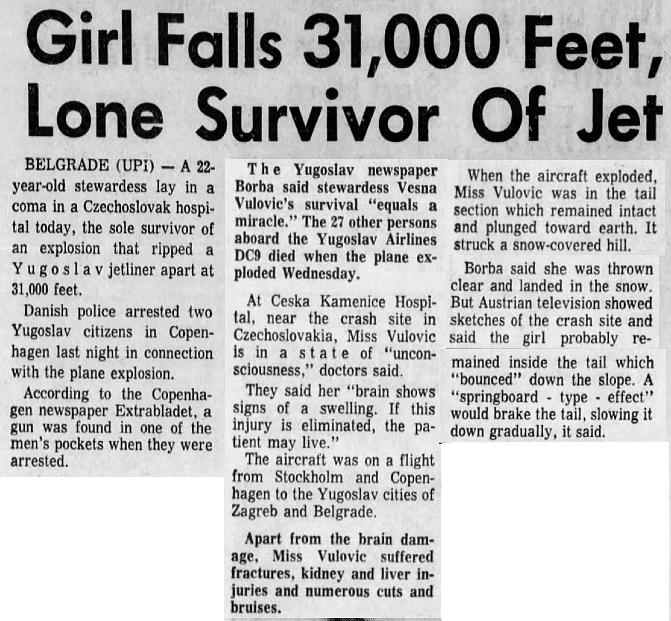Longest fall without a parachute
We've recently had a couple of posts about people surviving long falls. So this post (originally from Jan 2021) seemed relevant.
On January 26, 1972, stewardess Vesna Vulovic was working on a Yugoslav Airlines flight when a bomb blew up the plane. She fell 31,000 feet and miraculously survived. No one else on the flight did. She eventually made a near-full recovery and went back to work at the airline, though not as a stewardess. She died in 2016. To this day, she maintains the world record for having made the longest fall without a parachute.


Vulovic is part of a small group of human marvels who have survived very long falls. Another member of this group is English tail gunner Nicholas Alkemade who, in 1944, survived a fall of 18,000 feet out of a Lancaster bomber.
The question of how people are able to survive very-high falls has attracted some scientific interest. The most famous study on this topic, that I'm aware of, was published by Hugh De Haven in 1942: "Mechanical analysis of survival in falls from heights of fifty to one hundred and fifty feet". I've pasted a summary of his study below, taken from Newsweek (Aug 24, 1942). But basically his conclusion was that, if you're falling a long distance, hope that something breaks and cushions your fall.
On January 26, 1972, stewardess Vesna Vulovic was working on a Yugoslav Airlines flight when a bomb blew up the plane. She fell 31,000 feet and miraculously survived. No one else on the flight did. She eventually made a near-full recovery and went back to work at the airline, though not as a stewardess. She died in 2016. To this day, she maintains the world record for having made the longest fall without a parachute.

Pittsburgh Press - Jan 29, 1972

Vesna Vulovic. Source: wikipedia
Vulovic is part of a small group of human marvels who have survived very long falls. Another member of this group is English tail gunner Nicholas Alkemade who, in 1944, survived a fall of 18,000 feet out of a Lancaster bomber.
The question of how people are able to survive very-high falls has attracted some scientific interest. The most famous study on this topic, that I'm aware of, was published by Hugh De Haven in 1942: "Mechanical analysis of survival in falls from heights of fifty to one hundred and fifty feet". I've pasted a summary of his study below, taken from Newsweek (Aug 24, 1942). But basically his conclusion was that, if you're falling a long distance, hope that something breaks and cushions your fall.
A woman jumps out of a sixth-story window and walks away uninjured. Another slips on a banana peel and is killed. Why? That was the question Hugh De Haven asked himself...
Obviously, De Haven couldn't subject human guinea pigs to experimental accidents in a laboratory. Instead, he analyzed the records of some remarkably lucky and well-documented falls—cases where men and women dropped from as high as 320 feet (the equivalent of 28 stories) and survived. A few of them:
--A 42-year-old woman jumped from a sixth floor. Hurtling 55 feet, she landed at 37 miles an hour on her left side and back in a well-packed plot of garden soil. She arose with the remark: "Six stories and not even hurt." Her body had made a 4-inch hollow in the earth.
--A 27-year-old girl dropped from a seventh story window and landed head first on a wooden roof. She crashed through, breaking three 6- by 2-inch beams, and dropped lightly to the ceiling below. None of her neighbors knew about the fall until she herself appeared at the attic door and asked assistance. And although one of her vertebrae was fractured, the girl was able to sit up in bed the same day.
--Another woman fell 74 feet, landing flat and face down on an iron bar, metal screens, a skylight, and a metal-lath ceiling. The impact made a 13-inch bend in the 1.5-inch bar, but she suffered only some cuts on her forehead and soreness about the ribs. She sat up and climbed through a nearby window.
--After a 72-foot drop, a 32-year-old woman landed in jackknife position on a fence of wire and wood. She picked herself up and marched to a first-aid station but was unhurt.
--A 27-year-old man fell 146 feet onto the rear deck of a coupe. Some of his bones were broken, but he remained conscious and was back at work within two months.
--A man dropped from a 320-foot cliff to the beach below, bouncing from a sloping ledge halfway down. Although his skull was fractured, he fully recovered. DeHaven noted that the man wore a large coat, which may have slowed his fall by a slight parachute action.
--A woman fell seventeen floors onto a metal ventilator box, landing in sitting position and crushing the metal downward 18 inches. Though both arms and one leg were broken, she sat up and demanded to be taken back to her room.
In this evidence, De Haven observed that (1) in each instance the blow was distributed over a large area of the body, and (2) the fall was not halted abruptly—in the ventilator case, for example, it was slowed through a distance of 18 inches and the impact was thus decreased. Even so, she had survived a force of more than 200 times gravity. By contrast, a person slipping on a sidewalk might crack his skull because hitting the unyielding concrete pavement generated a force of more than 300 times gravity.
Obviously, De Haven couldn't subject human guinea pigs to experimental accidents in a laboratory. Instead, he analyzed the records of some remarkably lucky and well-documented falls—cases where men and women dropped from as high as 320 feet (the equivalent of 28 stories) and survived. A few of them:
--A 42-year-old woman jumped from a sixth floor. Hurtling 55 feet, she landed at 37 miles an hour on her left side and back in a well-packed plot of garden soil. She arose with the remark: "Six stories and not even hurt." Her body had made a 4-inch hollow in the earth.
--A 27-year-old girl dropped from a seventh story window and landed head first on a wooden roof. She crashed through, breaking three 6- by 2-inch beams, and dropped lightly to the ceiling below. None of her neighbors knew about the fall until she herself appeared at the attic door and asked assistance. And although one of her vertebrae was fractured, the girl was able to sit up in bed the same day.
--Another woman fell 74 feet, landing flat and face down on an iron bar, metal screens, a skylight, and a metal-lath ceiling. The impact made a 13-inch bend in the 1.5-inch bar, but she suffered only some cuts on her forehead and soreness about the ribs. She sat up and climbed through a nearby window.
--After a 72-foot drop, a 32-year-old woman landed in jackknife position on a fence of wire and wood. She picked herself up and marched to a first-aid station but was unhurt.
--A 27-year-old man fell 146 feet onto the rear deck of a coupe. Some of his bones were broken, but he remained conscious and was back at work within two months.
--A man dropped from a 320-foot cliff to the beach below, bouncing from a sloping ledge halfway down. Although his skull was fractured, he fully recovered. DeHaven noted that the man wore a large coat, which may have slowed his fall by a slight parachute action.
--A woman fell seventeen floors onto a metal ventilator box, landing in sitting position and crushing the metal downward 18 inches. Though both arms and one leg were broken, she sat up and demanded to be taken back to her room.
In this evidence, De Haven observed that (1) in each instance the blow was distributed over a large area of the body, and (2) the fall was not halted abruptly—in the ventilator case, for example, it was slowed through a distance of 18 inches and the impact was thus decreased. Even so, she had survived a force of more than 200 times gravity. By contrast, a person slipping on a sidewalk might crack his skull because hitting the unyielding concrete pavement generated a force of more than 300 times gravity.
Comments
I had previously read about the tail gunner's fall but the stewardess' story was a new one for me. The accompanying story of the falls study was also interesting. Thanks for the post.
Posted by Steve E. on 01/08/21 at 07:28 PM
Ms Vulovic's story was my amazing introduction to the Guinness Book many years ago. For the "anything-to-get-into-Guinness" crowd, this probably isn't a good one to try to beat.
Posted by Virtual in Carnate on 01/09/21 at 10:45 AM
After surviving something like that, winning a lottery would be topping on the journey of life.
Posted by KDP on 01/09/21 at 01:42 PM
Commenting is not available in this channel entry.

Reposted By: Alex - Sat Feb 05, 2022
Category: Human Marvels | World Records | 1970s